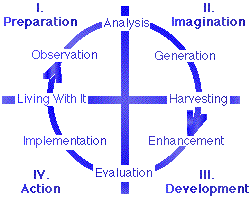
Models show sequence, interconnection, pattern, flow, and organization of thought over time. Models are critically important to mental functioning because they allow us to anticipate future actions, needs, and steps.The graphic presents our synthesis model -- The DirectedCreativity Cycle -- based on the concepts behind the various models proposed in the literature over the last 80 years.

Let's walk through it, beginning at the 9:00 position on the circle. We live everyday in the same world as everyone else, but creative thinking begins with careful observation of that world coupled with thoughtful analysis of how things work and fail. These mental processes create a store of concepts in our memories. Using this store, we generate novel ideas to meet specific needs by actively searching for associations among concepts. Seeking the balance between satisficing and premature judgment, we then harvest and further enhance our ideas before we subject them to a final, practical evaluation. But, it is not enough just to have creative thoughts; ideas have no value until we put in the work to implement them. Every new idea that is put into practice (that is, every innovation) changes the world we live in, which re-starts the cycle of observation and analysis.
Directed creativity simply means that we make purposeful mental movements to avoid the pitfalls associated with our cognitive mechanisms at each step of this process.
For purposes of explanation, we can further divide this model into the four phases shown. We will use these four phases of Preparation, Imagination, Development, and Action to organize the tools of directed creativity.
This page has opened in a new browser window.
To return to where you were, simply close this window.
You can access a more detailed version of
this page through the DirectedCreativity ToolKit page on the main site.
There you will find a working paper describing some of the many creativity
models
that have appeared in the literature over the past 80 years.
Simply close this new browser window and navigate back to that point.